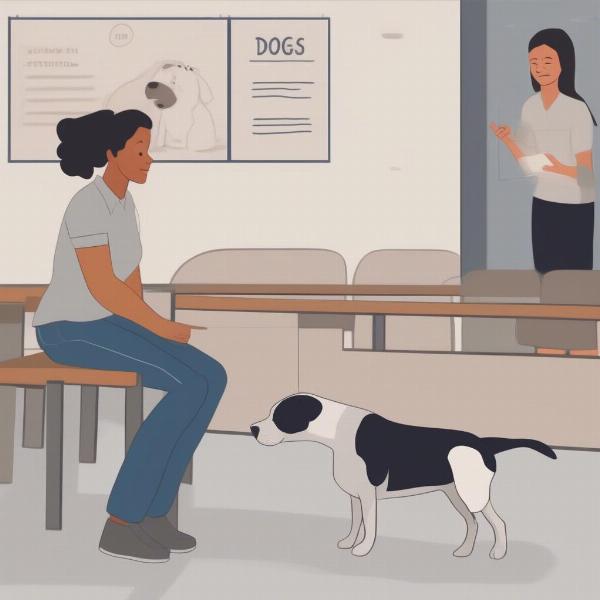Adopting a dog is a rewarding experience, but adopting a dog labeled as “aggressive” requires careful consideration and a dedicated approach. This guide provides essential information for anyone considering aggressive dog adoption, covering everything from pre-adoption preparation to building a strong, positive relationship with your new companion.
Understanding Aggressive Behavior in Dogs
Before embarking on aggressive dog adoption, it’s crucial to understand what “aggressive” truly means. The term is often misused and can encompass a wide range of behaviors, from fear-based reactivity to protective instincts. True aggression is rare. Often, dogs labeled aggressive are simply misunderstood, exhibiting fear, anxiety, or a lack of proper socialization.
Assessing Your Readiness for Aggressive Dog Adoption
Are you prepared to take on the challenges that come with adopting a dog with a history of aggression? This requires patience, consistency, and a commitment to ongoing training. Consider the following:
- Experience: Do you have prior experience handling dogs, particularly those with behavioral issues?
- Time commitment: Can you dedicate ample time to training, socialization, and providing a stable environment?
- Resources: Are you prepared for the potential costs of professional training, behavior modification, and veterinary care?
- Lifestyle: Is your current lifestyle conducive to a dog with special needs? Do you have children or other pets?
- Support system: Are there experienced dog trainers or behaviorists in your area whom you can consult?
Choosing the Right Dog
Not all dogs labeled “aggressive” are the same. Working with a reputable rescue organization or shelter experienced with aggressive dogs is crucial. They can provide valuable insights into the dog’s history, temperament, and triggers. Be honest about your experience and limitations. The right organization will match you with a dog whose needs align with your capabilities.  Choosing the right dog with history of aggression for adoption.
Choosing the right dog with history of aggression for adoption.
Creating a Safe and Stable Environment
A calm and predictable environment is essential for a dog with a history of aggression. Establish clear routines for feeding, exercise, and playtime. Provide a safe space where the dog can retreat when feeling overwhelmed. Minimize potential stressors, such as loud noises or sudden movements. electric collar for big dogs
Building Trust and a Positive Relationship
Building trust takes time and patience. Use positive reinforcement methods, such as rewarding desired behaviors with treats, praise, and toys. Avoid punishment, which can exacerbate aggression. Focus on building a positive association with you and your home.
Professional Guidance: A Key to Success
Working with a certified dog trainer or behaviorist specializing in aggression is highly recommended. They can assess your dog’s behavior, identify triggers, and develop a personalized training plan. This professional guidance can be invaluable in addressing underlying issues and promoting positive behavioral changes. hendersonville nc dog park
Managing Aggression Triggers
Understanding your dog’s triggers is crucial for managing aggressive behavior. Common triggers include strangers, other animals, specific objects, or certain environments. Once you identify these triggers, you can work with a professional to develop strategies for desensitization and counter-conditioning, gradually exposing your dog to the trigger in a controlled and positive manner.
Conclusion
Aggressive dog adoption requires a significant commitment, but the rewards can be immense. By understanding the underlying causes of aggression, creating a safe and stable environment, and working with a professional, you can help your new companion thrive and enjoy a fulfilling life. Remember, patience, consistency, and a positive approach are key to a successful transition. pitbull dog for sale
FAQ
- Is it safe to adopt an aggressive dog? With proper training, management, and professional guidance, it can be safe to adopt a dog with a history of aggression.
- What are the signs of dog aggression? Signs can include growling, snarling, lunging, biting, and a stiff body posture.
- How can I find a dog trainer specializing in aggression? Consult your veterinarian, local shelters, or search online for certified dog trainers or behaviorists experienced in aggression. blind dogs for adoption
- Can an aggressive dog be rehabilitated? Many dogs labeled aggressive can be successfully rehabilitated with proper training and behavior modification.
- What should I do if my adopted dog shows signs of aggression? Consult a professional dog trainer or behaviorist immediately for guidance.
- Can I adopt an aggressive dog if I have children or other pets? It depends on the individual dog, the severity of their aggression, and your ability to manage the situation safely. Consult a professional for advice.
- What are the legal implications of owning an aggressive dog? Laws vary by location; it’s essential to research and understand your local regulations regarding aggressive dogs. rescue for aggressive dogs
ILM Dog is your trusted resource for comprehensive dog care information. We offer expert advice on everything from breed selection and health care to training and nutrition. Whether you’re a first-time dog owner or an experienced handler, ILM Dog provides valuable resources to help you give your canine companion the best possible care. Contact us for personalized support: [email protected] or +44 20-3965-8624. Visit us at ILM Dog today!